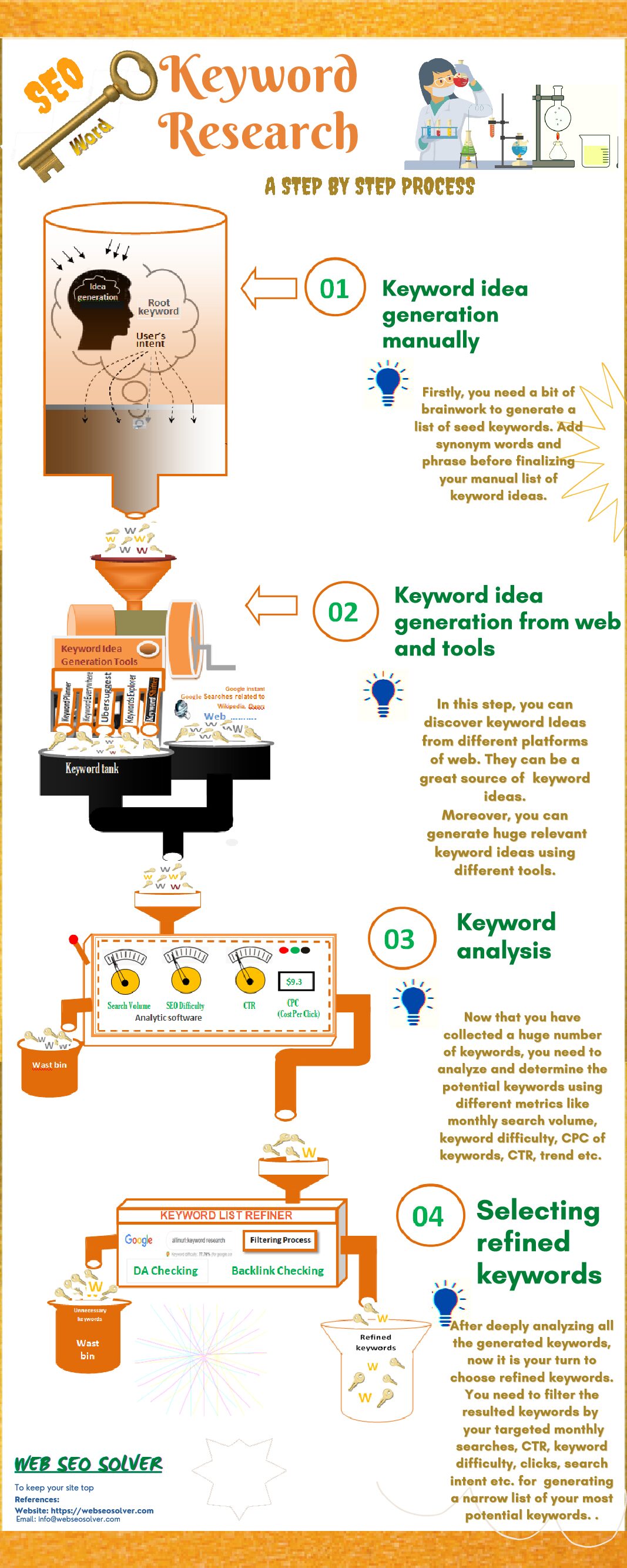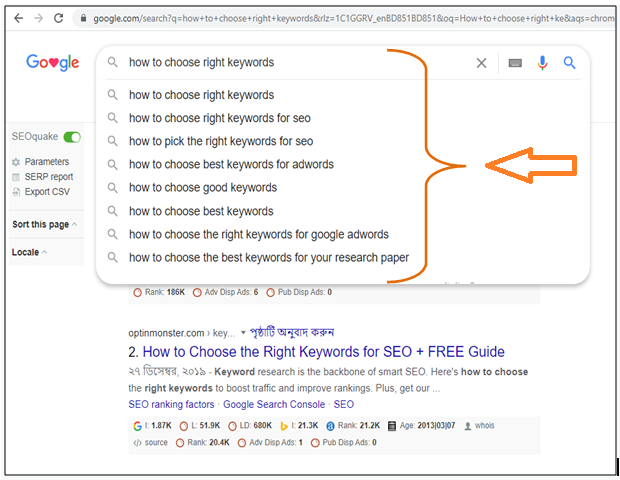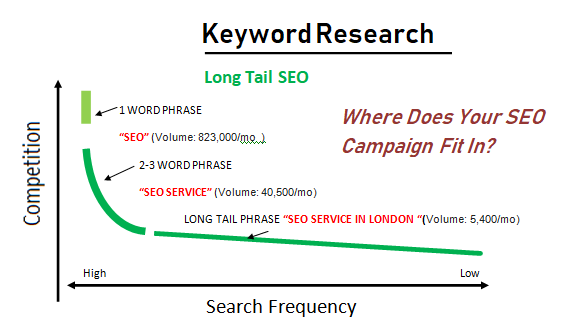
How to do keyword research step by step
Share this Image On Your Site
how to do keyword research step by step
Table of Contents
Keyword research basic
Keyword research is a process to find out basically the right keywords for the web content. A keyword is the core of the whole SEO process. SEO is responsible for the online top visibility of any business and services. Therefore, selecting the right keyword is essential for promoting any business and services in the search engines and converting traffic into leads and sales. This is in fact the ultimate goal of any blog or website. But how can we know the selected keyword is right or wrong for a business?
We know selecting the right keywords will make money but selecting the wrong keywords can harm a lot. Again, different people may answer the same search query (keyword) in different ways for achieving different goals. Also, the same content can rank for different keywords. Thus, there are lots of complexities and variables in selecting the right keywords for the content. So, from that aspect, it’s not the easy way to write down a step-by-step guide for how to do keyword research.
When you do SEO for your web content, you are, suppose, getting enough traffic without any conversion into customers or leads. Or, maybe you are struggling to reach the peak in SERP year after year spoiling huge time and money with no result. Or, you are experiencing a high bounce rate or low click-through rate on the pages that hurt your earnings. So, some keywords bring in more traffic, some keywords bring in little to no traffic. Some keywords get a high click-through rate and some do not.
All these problems may arise due to making faults in selecting the right keywords. Choosing the right keywords for the web content of your business and services can provide you a logistic solution of all these you are facing and can lead you to well earnings. But the job requires deep research in discovering the right keywords, analytic observation, far-reaching plan to reach the goal. Yes, it is keyword research that will cover everything as I mentioned above, and will precede you to the right goal.
Let’s start the war now.
Here is the guide for keyword research in step by step process.
- Step-1: Keyword idea generation manually
- Step-2: Keyword idea generation from web and tools
- Step 3: keyword Analysis
- Step-4: Pros and cons of keywords in SEO from analysis
- Step-5 : Selecting right/refined keyword
Before we start the keyword research, we need to select a web content targeting the business goal. After confirming the content selection, we need to decide and choose a few good focused /seed /root keywords (5-20) to generate more and more keyword ideas on that content. Always try to select seed keywords more specific and relevant to your web content and business goal.
Now, what is a keyword idea? Keyword ideas are a possible list of keywords that generates from seed keywords and represents the content of your website. It also expresses how people think about your business in web content or niche. So, the keyword ideas should have matching with both the user’s intent and website content strategy to respond exact answer of the user’s search query. Remember that these keywords are the foundation of your SEO strategy. Keyword ideas can be many, but not all of them are the right keywords.
Choosing the right keywords requires keyword idea analysis.
Keeping that target in front let’s see at first how can we generate more keyword ideas? Then we shall go for Keyword Analysis.
There are two steps for creating keyword ideas for web content.
They are–
1) Manually
2) Using tools
Step-1: Keyword idea generation manually
It is the initial step of doing keyword research. It’s just like guessing about user’s intent. Users search by what kind of keywords to get your website content.
Here, you need a bit of brainwork to generate a list of keywords.
You can also extend the list by discussing.
Also, add synonym words and phrase words before finalizing your manual list of keyword ideas.
For learning details on how to generate keyword ideas manually take a look at how to do keyword research manually.
how to do keyword research step by step
Step-2: Keyword idea generation from web and tools
At first, we see Keyword ideas from the web.
Finding Keyword Ideas from the different web platforms using different policies:
Google auto complete :
Firstly go to Google auto complete to find keyword ideas.—
In the search bar type your focused /seed /root keyword and follow Google’s instant search results.
In Google instant, you will certainly get a few keyword ideas and write down that you seem relevant.

Related searches:
Google’s related searches are based on an algorithm to determine terms related to your search query.
They are also based on previous searched history or the user’s current search.
It is at the bottom of Google’s result page.
Write down some keywords that you seem more relevant.

YouTube suggestion:
Youtube is the second+ largest search engine in the world. You can get keyword suggestions also from YouTube instant searches.
Keyword suggestion from Forum sites :
Forum is divided up into sections where you can get potential keyword ideas to enrich your list.
Keyword idea from Wikipedia :
Around the web, wikipedia is an important article site. It contains huge keywords in articles that reflect many contemporary users. These keywords are lucrative too.
Here you look at the list of content of Wikipedia on dog food keyword that provides a good number of underlined keyword ideas..

Keyword idea from Answer and Question site: quora.com:
Quora is a great question and answering site. It assumes many relevant questions and answers around a topic visited by a large volume of traffic.
So, they can be a source of collecting keyword ideas.
Keyword idea using Tools
Here is how to generate keyword ideas using tools.
In this step, a lot of tools and tactics can help you generating a lot of keyword ideas.
Keyword planner
It is Google’s product. You can use this tool for free to discover new keyword ideas.
Just enter the root keyword closely related to your business and hit on button get results.

Keyword everywhere
Keywords Everywhere is a freemium extension tool that helps in keyword research providing their accurate monthly search volume, CPC, and competition data. It is now a paid tool and can be easily installed on either Chrome or Firefox.
Keyword shitter provides data from keyword everywhere.
Ubersuggest
Ubersuggest is keyword research and suggestion tool. It provides keyword ideas with metrics for keyword research, SEO, PPC, and content marketing. To get results from this tool just type the keyword or domain in the search box and hit the search button. It is now a paid tool though offers limited free services.

SEMRUSH
Semrush is an all-in-one tool suite for improving online visibility. It has keyword research tool that provides all the keywords you need for successful SEO. It is a paid tool to recommend. Just enter a seed keyword in the search bar and you will get a list of suggested and related keywords with different metrics.

Ahrefs
Ahrefs.com is a well-known toolset that provides valuable information about backlinks and SEO analysis including keyword research. Ahrefs ‘Keyword explorer’ is a complete keyword research tool. It provides thousands of keyword ideas with different metrics and analyses. It has both free and paid facilities for solutions to SEO.
Step – 3: Keyword analysis
All the tools discussed above give us a list of a large number of keywords for SEO with some metrics that act as traits of keywords. These metrics are monthly search volume, keyword difficulty, CPC, click-through rate, etc. that help to analyze the keywords for selecting refined keywords. We have to come up with a minimum number of keywords from a large number of keyword ideas by dropping off the less-value keywords through analysis.
Let’s first introduce all the metrics of keywords. Then we will go for keyword analysis.
Here is a SEMRUSH tool data on different metrics.

Monthly search volume
Monthly search volume refers to the amount or quantity of searches for a specific keyword on monthly basis. Search volume of a keyword can be low or high. These metrics keep an important role in selecting the right keywords.
On the basis of keyword analysis, it is mostly found that monthly search volume of a keyword depends on the number of words in the phrase of keywords. Single words or generic phrase keywords are much more competitive with their high search volume since visitors are researching there. Bigger sites always grab the pick position of these keywords. So, it will be difficult for brand new sites to compete.
On the other hand, long-tail keywords are usually low search volume and low-competition keywords. But, these keywords are highly converting. These keywords may bring potential customers to your business. At this level, visitors are ready to buy. Higher search volume is usually better when you are going to earn from advertisements. But it is very difficult to get a high rank due to the high demand for keywords. So, a high-ranking post with fewer visitors is better than zero visitors with a low ranking. Now it is your option whether you prefer short keywords or long keywords against monthly search volume.

Keyword difficulty
Keyword difficulty or SEO difficulty is a metric to understand the competition for a keyword to rank on the search engine result page. It is scaled from 0 to 100.
The higher the value of the difficulty metric the harder the keyword will be to rank on the 1st page of the SERP.
And the lower the value ideally scored less than 40, the easier it is to rank.
Though keyword difficulty is not to encourage or discourage you to select a particular keyword, it sharp provides you information on how difficult the keywords would be to rank.
CPC (Cost per Click)
CPC is a metric to judge a keyword’s status. Increased keyword CPC helps to reach it to more qualified audience.
Typically, the higher the value in CPC the more likely it is to convert the visitors into customers. The lower the CPC usually means the keyword does not drive as qualified traffic and does not convert as well.
Lower SEO difficulty and high CPC rate keywords can tend to drive the most revenue for you.
Search intent:
Search intent or user intent is basically the intention of the user behind typing a query into a search engine. This query is no more than a keyword. There is a big effect of the user intention on the goal of marketing. For that reason, user intention behind keywords is important for the success of marketing. Analyzing keywords by intent should be the first step of keyword analysis. No matter how much search volume or other metrics a keyword has. If those keywords are not relevant to your business, your time and/or money will spoil.
Google is devoted to understanding user intent. Its algorithm can identify the intent behind the search and deliver intent-oriented results. So, discovering intent-driven keywords is an important step of keyword analysis.
There are four stages of search intent that include informational, commercial, navigational, and transactional. Always select the keywords tactfully that favor your stage or the goal of business.
Keyword trends
Keyword trend is another interesting metric to do keyword research. It is rated on a scale of 0 to 100. Google trend is a keyword trend tool for keyword analysis. It helps to understand monthly search volume with popularity trend, seasonal trend, local search trend, related keyword idea, breakout keywords etc.
CTR (Click-through rate):
The Click-through rate is the ratio of click to impression.
Clicks ÷ impressions = CTR
CTR = 100 (Clicks) ÷ 2,000 (Impressions) = 0.05 ; 0.05 x 100 (percentage) = 5% CTR
It is a measure of how often the users click the keyword. Each of the keywords has their own CTRs. A high CTR indicates that the keyword is relevant, helpful and successful to your business. This is because the more your keywords relate to your business the more likely a user is to click on it. On the contrary, the low CTR indicates that the keywords are not good match for your target audience. So, click-through rates can greatly help in keyword research to select the right keywords. Thus, from CTR metric you can easily guess how much traffic you can expect from rankings the keywords. CTR metrics also provide an idea of the conversion rate of the keywords.
Here is a Moz tool data on different metrics.

KGR (Keyword Golden Ratio):
Keyword Golden Ratio (KGR) is the number that helps to identify low competition keywords, especially for a new website. KGR is the ratio of the number of Google results that have the keyword phrase in the title to the monthly search volume of that key phrase.
KGR = allintitle (Google search operator) result number ÷ monthly search volume
The study reveals that if the KGR is less than 0.25(KGR < 0.25), then you should rank in the top 50 just as your page is indexed.
When the KGR is between 0.25 and 1 your keywords should rank in the top 250 and it should be pretty fast. Again, if a KGR is above 1.00, the keyword will be harder to rank.
Thus, KGR helps to identify and accumulate low competition and competitive keywords.

Step-4: Pros and cons of keywords in SEO from analysis
So far we have learned how to analyze this large volume of keywords. Let us now go to judge the pros and cons of keywords from keywords analysis.
Before going to judge keywords by metrics, the most important thing is to remind your business goal. Which keywords to keep and which one to omit will depend on your business goal and you can judge it by user intention behind your accumulated keywords. This is the first step for picking the right keywords. If the users need to gain general knowledge on a topic, they search using informational keywords. But if the users are intent to buy the products they search using transactional keywords. Your business goal needs to match with the specific user’s intent that will help in choosing the right keywords.
Now you need to think with the business goal in mind whether you want long-tail keywords or short keywords. Remember, long-tail keywords are less competitive but highly converting. On the contrary, short tail keywords though have high search volume, are highly competitive, and have zero or less conversion rates.
Keyword difficulty will provide you with an idea about how difficult will be the keyword to rank. In most cases, lower keyword difficulty and high CPC rate keywords can tend to drive the most revenue for your business. Keyword trends will tell you the idea about the duration of keyword popularity, seasonal trends, and local search trends. CTR metrics can also help you to select the right keywords. Keyword with high CTR metric generally indicates high-quality traffic and a good conversion rate.
In this way, you can judge the pros and cons of your collected keywords and choose your desired right keywords for your business or other purposes considering all aspects.
Step – 5 : Selecting right/ refined keyword
Now that you have discovered huge keyword ideas and learned how to analyze them, it is your turn to choose refined keywords. This is because refined keywords fit better with your new and existing SEO campaigns. They are excellently matched with your business to generate profit.
But, the question is how to get refined keywords from this large volume of keyword ideas.
Different tools provide facilities to make this process easier for you to find refined keywords that fit with your campaigns.
Firstly, you can filter your resulted keyword ideas by keyword text, average monthly searches, CTR, keyword difficulty, Clicks, search intent, etc. for the target of generating your high potential desired keywords. You have to do this job very carefully keeping in mind the idea of keyword analysis as mentioned above and your business goal.
Look at the ahrefs tool for filtering different metrics resulting a narrow list of keywords.

By targeting location settings, language settings, etc you can narrow the keywords. Use trend tools for knowing the popularity of keywords or seasonal trends. Thus filter attributes will help you to remove unnecessary keyword ideas from the list.
In all the filtering processes you need to ask yourself the questions. What potential do the keywords bring to your business? Do these keywords give value to your business goal? Do these keywords satisfy the intent behind the search of the users?” If the answer is “yes”, you can proceed with those keywords.
Thus you will certainly get a narrow list of potential keywords for your SEO campaign.
When refining keywords, you can group together ideas based on the attributes of your product or service.
You need to do it because it can tremendously affect the effectiveness and pace of your SEO efforts – now and in the future.
Keyword grouping tool can help you in this regard.
Conclusion:
Keyword research as discussed above is enough to make you ready to start a successful SEO campaign for your site. This keyword research strategy is able to help you find and analyze potential keywords and determine the right keywords that you truly need for SEO. By optimizing the refined keywords in the content you can certainly reach your business to the right goal. Thus, successful keyword research can promote your business or service in search engines and convert traffic into leads and sales to raise revenue.
Let us know if we miss anything. Finally, it’s your turn to walk.
how to do keyword research step by step
how to do keyword research step by step
Related Post:

